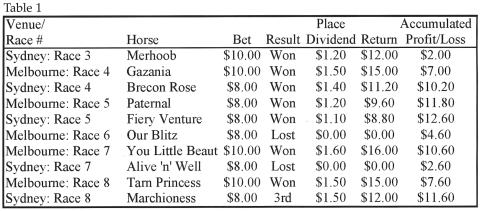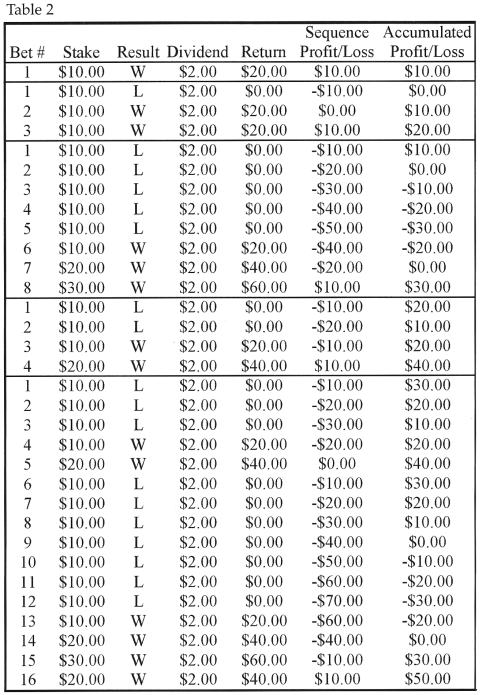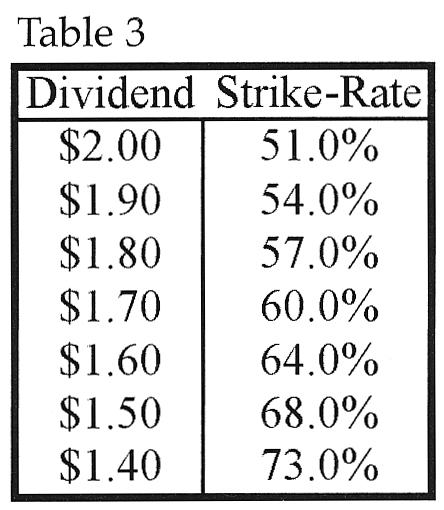In this article, our senior contributor E. J. Minnis replies to queries sent in by PPM readers. Please send any questions to: The Editor, PPM, PO Box 551, Dee Why, NSW 2099.
I have been a PPM reader for quite a while now and although the magazine often contains staking plans for win punters, I can't recall reading about one for place punters.
As I've been successful as a place punter now for a number of years, could you recommend a suitable staking plan one that doesn't escalate the bets too quickly?" asks Marcus Beeble of Melbourne.
Perhaps one of the best place staking plans that I have ever encountered is one that was published in PPM in 1985 - the Partial Place Plan, developed by Statsman.
Details of two staking plans are provided for consideration for your place betting activities.
The first is the aforementioned Partial Place Plan and the second is a plan known as Oscar's Grind, developed by a roulette-playing gambler at the casinos.
THE PARTIAL PLACE PLAN
- Start every series with a $10 wager (or a multiple) on the first bet. After the successful completion of any series the first bet in the new series reverts once again to $10.
- After every loss, raise the stake by $2 (one-fifth of the first or base bet). After every winning bet, drop the amount of the next bet by $2, provided the tote dividend is $1.50 or better. If the tote dividend is less than $1.50, then repeat the same bet.
- Each series is favourably ended when a $2 bet is successfully made, i.e. there have been sufficient winning bets for the stake to drop from $10 down to $2.
I did a "snapshot" test on a recent Saturday, using similar rules to the original but basing mine on the SP's on favourites quoted at $5 or less (no odds-on) and only in fields of eight to 12 runners in Melbourne and Sydney. Refer to Table 1 to see how the test went.

With seven of the selections winning with eight placegetters, it was certainly a good day for favourite backers and results like these will not be achieved on an ongoing basis without some discretion in the selection method being used.
However, most place punters would be aiming for a strike rate close to, if not better than, 80 per cent and a few of the dividends in the test were a bit on the low side, so a small drop in the strike rate could be more than offset by increased dividends on the winning selections.
Overall a l-unit profit at level stakes, returning a POT of 10 per cent, while the staking plan marginally improved the profit with less outlay, returning a POT of 13.2 per cent.
OSCAR'S GRIND
This should only be used for place betting where there is a positive edge in favour of the punter and coupled with selections that have at least a 50 per cent strike rate.
For this plan to be operated effectively, the average winning dividend needs to be at least $2 assuming a minimum strike rate of 51 per cent.
If neither of the above two conditions are true, then this plan will not work and, as the name implies, it will grind you down eventually into a loss situation.
The preferred minimum strike rates are 55 or 60 per cent, either of which would require only an average dividend of $2 to work effectively.
- The target for each sequence of bets is 1 unit ($10) profit, with the first bet being 1 unit ($10).
- After a losing bet, the next bet is always the same size as the previous one.
- After a win, the next bet is 1 unit more than the previous one.
- Whatever larger bet might otherwise be indicated by rule 3, the bet size should only ever be large enough to gain 1 unit profit on the sequence.
As mentioned, the first bet is always 1 unit and if the bet wins, the sequence ends and the next sequence commences.
If the first bet loses, the next bet is again 1 unit. If the second bet also loses, then the next bet is still 1 unit and so on until a winner is found.
If the second bet in a sequence (following a losing first bet) wins, the next bet in this instance is still only 1 unit because a bet of this size, assuming a minimum dividend of $2, is sufficient to gain a 1 unit profit on the sequence (refer to the second sequence in Table 2).

To prove the viability of Oscar's Grind, I ran a simulation of 5000 bets using a $2 dividend and a 51 per cent to 49 per cent ratio of winning bets to losing ones.
Overall, it did better than expected, for while the level-stakes profit was a mere $500 (POT 1 per cent), the staking plan profit amounted to $4020 (POT 7.6 per cent).
Table 2 is a section of the simulation to demonstrate how the plan works - a total of 32 bets covering five winning sequences. Surprisingly, only 14 winning bets to 18 losing bets, yet a profit of $50 (POT 12.2 per cent).
The first bet in sequence one wins so it concludes and the second one commences with a losing bet, followed by two winning bets, which gained the 1 unit profit required - there was no need for an increase in stakes for the third bet (as per rule 4).
The first five bets in sequence three all lost but the three winning bets that followed were sufficient for the 1 unit profit to be made, while the fourth sequence went for only four bets before the target was reached.
The fifth sequence is probably the most interesting and is an indication of how the staking plan can "grind" away before the target is reached. Again the last bet in this sequence was influenced by rule 4, as to complete the sequence a bet of just $20 was required and not one of a higher amount.
I'm not sure that I can guarantee that a performance of this nature can be maintained long-term, but it is conservative in its approach. Table 3 displays the MINIMUM dividend /strike-rate ratio required to operate the Oscar's Grind staking plan effectively.

By E.J. Minnis
PRACTICAL PUNTING - MARCH 2003